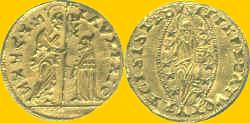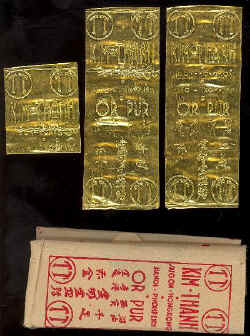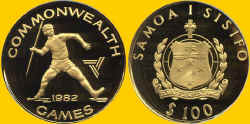This is the Worldwide Numismatics Website!
This is a modest collection of second millennium gold coins
Click the thumbnail picture to see a larger version of the picture, then use your browser BACK button to return to the original page you were viewing.
VATICAN CITY
The history of the Vatican as a papal residence dates from the 5th century when, after Emperor Constantine I had built the basilica of St. Peter's, Pope Symmachus built a palace nearby. The pope usually resided in the Lateran Palace until the “Babylonian captivity” (14th century) in Avignon, France. After the return of the papacy to Rome (1377) the Vatican became the usual residence. The Holy See's diplomatic history began in the 4th century, but the boundaries of the papacy's temporal power have shifted over the centuries. In the middle of the 19th century, the Popes held sway over the Papal States, including a broad band of territory across central Italy. In 1860, after prolonged civil and regional unrest, Victor Emmanuel's army seized the Papal States, leaving only Rome and surrounding coastal regions under papal control. In 1871, Victor captured Rome itself. The following year Victor Emmanuel entered the city and declared it the new capital of Italy, ending papal claims to temporal power. Pope Pius and his successors disputed the legitimacy of these acts and proclaimed themselves to be "prisoners" in the Vatican. Finally, in 1929, the Italian Government and the Holy See signed three agreements resolving the dispute: a treaty recognizing the independence and sovereignty of the Holy See and creating the State of the Vatican City; a concordat defining the relations between the government and the church within Italy; and a financial convention providing the Holy See with compensation for its losses in 1870. A revised concordat, altering the terms of church-state relations, was signed in 1984.
100 Lire - 1934
Y-019 - 8,80 g
Mintage
- 0,023M
This coin was minted to commemorate the Jubilee Holy Year of 1934. The obverse pictures Pope Pius XI (Achille Ratti, b1857-d1939). The Latin inscription reads PIUS XI MAXIMUM PONTIFF JUBILEE YEAR. The reverse has a standing image of the Saviour. Around the perimeter is the Latin inscription STATE OF THE CITY OF THE VATICAN. The dates 1933 and 1934 are at the sides of Jesus with the denomination below.
There are more Vatican gold coins in this section if you are interested - Page Vatican 1
VENEZUELA
Christopher Columbus encounterd Venezuela, the homeland of the Carib and Arawak Indians, on his third voyage to the New World in 1498. The area was named Little Venice by the European explorers in 1499 when they saw how the Indians built their villages on pilings over Lake Maracaibo. In the 1500's Spain sent many expeditions to explore the possibilities of settlement and future development, which led to the founding of the city of Caracas by Diego de Losada in 1567. This spread to the colonization of Venezuela throughout the 17th century. Venezuela's economy grew quickly in the 18th century and Caracas became its focal point, providing administration to the provinces of Venezuela, and its judicial, military and educational institutions. With the influences of other continents came the decline of the Spanish Colonial Period by 1810. Venezuela was part of the formation of Gran Columbia, which included Colombia and Ecuador, from 1820 until 1830 when the confederation broke apart and Venezuela became an independent nation. The 19th century was flooded with dictators, civil wars and poverty. The early 1900's came with German and British blockades on the coast, and relations with the United States being broken by 1908. Throughout the 1920's and 1930's focus was put on establishing good relations with foreign powers and opened its arms to multinational oil companies. By the mid 1900's Venezuela's social and economic outlook changed for the better which led to a more modern constitutional system.
20 Bolivares - 1912
Y-032 - 6,45 g
Mintage
0,150M
This coin was minted at the Paris mint and has a bareheaded bust of Simon Bolivar (b1783-d1830). Simon Bolivar was one of South America's greatest generals. His victories over the Spaniards won independence for Bolivia, Panama, Colombia, Ecuador, Peru, and Venezuela. He is called El Liberator (The Liberator) and the "George Washington of South America." The Spanish inscription reads BOLIVAR LIBERATOR. Below the bust is the coin's designer Barre with the privy marks on either side. The reverse has the national arms. At the top the Spanish inscription reads UNITED STATES OF VENEZUELA. The alloy's statistics circle the bottom with the date in the centre.
There are more Venezuela gold coins in this section if you are interested - Page Venezuela 1
VENICE
According to tradition, Venice was founded in 421 AD on 25 March, St. Mark's day, who is the patron saint of Venice The most important village in the lagoon by that time is not Venice but Torcello, where in 639 the gorgeous cathedral was built, and where many people are seeking refuge from barbarian invasions. In Venice the Doges' government is established: the first historically known doge is Orso Ipato (in 726). The year 814 is the starting date of the construction of Palazzo Ducale (Doges' Palace) in what i s today St. Mark's Square. The Basilica St. Mark's instead was began in 834, but this first basilica went burnt down. Venice is spreading its commercial boundaries: in 1000 its fleet defeats the pirates of the Adriatic sea. Then Venice takes part to the Crusades, the war campaigns aimed to free Jerusalem. For Venice this is a business opportunity and expansion chance as well. Many works of art are taken to Venice as a booty: for instance, the four bronze horses of St. Mark's. The original bronzes can now be seen in St. Mark's museum, whilst the four horses on the Basilica's facade are perfect copies. The journey of the Venetian merchant Marco Polo from Venice to China is one of the most fascinating true stories of Middle Ages (1271-95). His adventure and the meeting with Ghengis Khan are told in the book 'Il Milione' In 1348, Venice population is halved by the plague. In spite of this, Venice succeeds in becoming the leader of the 4 seapowers of Mediterranean Sea: the other ones were the Republics of Amalfi, Genoa and La Spezia. In 1489 Venice conquers the island of Cyprus. In 1516 the first ghetto in the world is founded in Venice. Another great plague affects Italy in 1630, and for Serenissima Repubblica this is the beginning of the decadence. Repubblica Serenissima di Venezia, the Venetian Republic, was defeated by Napoleon in 1797 and it became a part of the Hapsburg Empire (Austria). Venetians attempt to free their land from the Hapsburg (1848). In 1860 the army of Giuseppe Garibaldi make it possible for Italy to become a nation under the reign of the Savoia dynasty. Venice joined Italy in 1866 after the 3rd Independence War.1 Zecchino - 1556-92
Fr-1255
- 3,49 g
Edge - Smooth
This coin was minted by the Venetian Republic under Doge Lorenzo Priuli. The obverse has a figure of the kneeling Doge receiving the gonfalon from St. Mark. The legend on the right reads LAVR-PRIO and the word DVX is to the right of the Doge's staff. The legend to the left of St. Mark says S.M.VENET (Sacred Money Venezia). The reverse has a standing figure of Christ in Glory facing forward with right hand bent upwards within convex lens known as a mandorla with 13 stars with 6-points along inner periphery. At the left is the legend SIT-T-XPE-DAT-V and to the right is REGIS.ISTI.DVC which expands to Sit tibi, Christe, datus, quem tu regis, iste ducatus which translates as "To thee, O Christ, duchy, which thou rulest, be dedicated." These coins were minted from 1280 through 1545 where they were denominated as Ducas. From 1545 through 1797 they were denominated as Zecchinos. These coins were trade coins and were accepted throughout the known world.
VIETNAM
1
Tael - ca 1965
37,500
g
This packet of 2.5 fold wafers was sold by Kim Thanh to Vietnamese boat people (refugees) fleeing the communist takeover of the Republic of Vietnam. This was the only way they could smuggle out any of their assets to start life anew somewhere else. These refugees had these packets sewn into their clothing or in makeshift money belts during their escape from communist tyranny. Many of these refugees were processed through Orote Point on the island of Guam where gold traders from Hong Kong converted their gold into US dollars or other hard currencies. While not coins, these are important numismatic pieces demonstrating the value of gold versus paper currencies.
WESTERN SAMOA
The islands were originally settled about 1000 BC a date arrived at by the dating of shards of Lapida pottery found at Mulifanua. By 200 BC Samoa was the center of a flourishing Polynesian community with trade taking place between Tonga, Fiji and Samoa. In about 1300 AD a group of settlers from Samoa colonised the Tokelau islands, explaining the similarity between the two languages. Dutchman, Jacob Roggeveen, was the first European to sight the islands, in 1722. Louis-Antoine de Bougainville, French explorer, named the islands the Navigator Islands in 1768, after encountering Samoans in ocean-going canoes. In 1787, the French ship La Perouse landed on Tutuila and a shore crew were attacked, leading to the death of 12 people. John Williams and Charles Barf, two missionaries from the London Missionary Society, arrived at Samoa in 1830 and were responsible for the introduction of Christianity and destruction of the traditional Samoan religion. In 1857 J.C. Godeffroy and Son (taken over by German Trading and Plantation Company when their business failed) a German company founded their depot in Apia, a move which lead to Samoa becoming the most popular trading post in the Pacific at that time. The Treaty of Berlin was signed in 1889, which guaranteed that Samoa would retain political independence under the control of it's own king, who would be advised by the American, British and German consuls. On 2 December 1899 the Tripartite Treaty replaced, Treaty of Berlin and Western Samoa passed into the hands of Germany, whilst America gained what is now called American Samoa. In 1914 at the outset of the First World War, New Zealand took control of Western Samoa, replacing Germany as it's colonial master's, and retained it when the war ended under a mandate from the League of Nations. A major change in government was made in 1947 when the Samoan Legislative body was altered such that it was composed of a Samoan majority and granted substantial powers. Western Samoa was the first Polynesian state to gain, independence obtaining it from New Zealand in 1962. In 1970 it became a member of the Commonwealth. In July 1997 Western Samoa formally adopted the name "Samoa".
$100 - 1982
KM-052
- 7,505 g
Edge - Reeded
Mintage - 1.000
This NCLT "coin" was issued to commemorate the Commonwealth Games. The obverse has a figure throwing the javelin with COMMONWEALTH GAMES around the circumference. The date 1982 is between the athlete's legs. The reverse has the country's arms with the legend SAMOA I SISIFO around the top and the denomination $100 below.
If you would like to see additional gold coins, please click here - Page 36
If you want to return to the home page, please click here - Home


